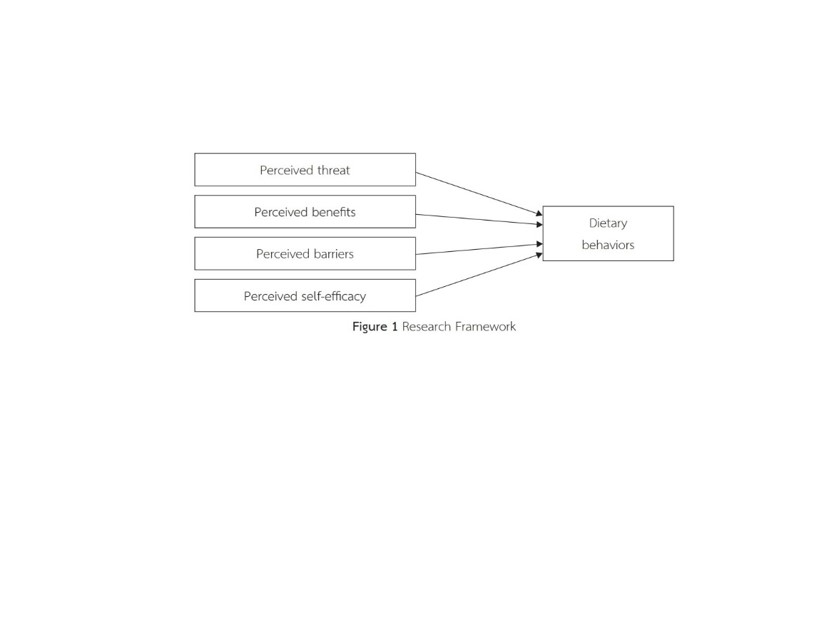FACTORS INFLUENCING DIETARY BEHAVIORS OF ADULTS WITH RECURRENT KIDNEY STONES IN WENZHOU, CHINA
คำสำคัญ:
adults, dietary behaviors, recurrent kidney stones, health beliefsบทคัดย่อ
Recurrent kidney stones pose a significant global health concern, emphasizing the crucial role of appropriate dietary practices in their prevention. This research, grounded in the Health Belief Model, delves into the dietary behaviors and underlying factors influencing individuals with recurrent kidney stones. The study cohort comprised 110 adults with recurrent kidney stones, selected via simple random sampling from the First Affiliated Hospital of Wenzhou Medical University in Wenzhou, Zhejiang Province, China. Utilizing instruments such as demographic questionnaires, the Health Belief Scale, and the Dietary Behaviors Scale, data analysis was conducted employing descriptive statistics and multivariate regression analysis.
The findings underscored a mean dietary behavior score of 55 out of 95 (SD = 8.6), indicating a moderate level of adherence to recommended dietary guidelines. Notably, perceived threat, perceived benefits, perceived barriers, and perceived self-efficacy collectively elucidated 20.4% of the variance in dietary behaviors among adults with recurrent kidney stones. Particularly, perceived threat and perceived barriers emerged as significant predictors of dietary behaviors (β = .287, p < .001; β = -.409, p < .001, respectively). These results underscore the importance of targeted interventions aimed at enhancing dietary behaviors among this demographic. Nurses and healthcare providers are urged to furnish tailored information that addresses specific barriers and heightens perceived threat, thereby fostering preventive measures against recurrent kidney stones.
เอกสารอ้างอิง
Akokuwebe, M. E., Odimegwu, C., & Omololu, F. (2020). Prevalence, risk-inducing lifestyle, and perceived susceptibility to kidney diseases by gender among Nigerians residents in South Western Nigeria. Afr Health Sci, 20(2), 860-870. doi:10.4314/ahs.v20i2.40
Brislin, R. W. (1976). Comparative research methodology: Cross-cultural studies. International Journal of Psychology, 11(3), 215-229. doi:https://doi.org/10.1080/00207597608247359
Champion, V. L., & Skinner, C. S. (2008). The health belief model. In K. Glanz, B. K. Rimer, & K. Viswanath (Eds.), Health behavior and health education: Theory, research, and practice (pp. 45-65). 989 Market Street, San Francisco: Jossey-Bass.
Cheng, Q., & Han, B. (2019). The correlation between dietary factors and kidney stones. Public Medical Forum Magazine, 23(32), 4606-4608. doi:10.19435/j.1672-1721.2019.32.012
Cohen, J. (1977). CHAPTER 9 - F tests of variance proportions in multiple regression/correlation analysis. In J. Cohen (Ed.), Statistical power analysis for the behavioral sciences (pp. 407-453): Academic Press.
D'Costa, M. R., Haley, W. E., Mara, K. C., Enders, F. T., Vrtiska, T. J., Pais, V. M., Jacobsen, S. J., McCollough, C. H., Lieske, J. C., & Rule, A. D. (2019). Symptomatic and radiographic manifestations of kidney stone recurrence and their prediction by risk factors: A prospective Cohort Study. Journal of The American Society of Nephrology, 30(7), 1251-1260. doi:10.1681/asn.2018121241
Doan, Q. A., & Preechawong, S. (2014). Factors related to dietary behaviors in Vietnamese persons with recurrent kidney stone post-operation. Journal of Health Research, 28(6), 413-418.
Fontenelle, L. F., & Sarti, T. D. (2019). Kidney stones: Treatment and prevention. Am Fam Physician, 99(8), 490-496.
Huang, J. (2019). Chapter 8: Guidelines for diagnosis and treatment of urinary calculi. In J. Huang (Ed.), Chinese guidelines for the diagnosis and treatment of urological and andrological diseases (pp. 260-263). Beijing: Science Press
Iremashvili, V., Li, S., Best, S. L., Hedican, S. P., & Nakada, S. Y. (2019). Clinical and demographic predictors of repeat stone surgery. BJU Int, 124(5), 836-841. doi:10.1111/bju.14844
Jiafeng, Z., Jianchang, G., Maoquan, Y., Shihui, D., & Lane, Z. (2023). Ischemic heart disease burden attributable to high-salt diet and the trendchange from 1990 to 2019 in China. Chinese Circulation Journal, 38(03), 337-342.
Khan, S. R., Pearle, M. S., Robertson, W. G., Gambaro, G., Canales, B. K., Doizi, S., Traxer, O., & Tiselius, H. G. (2016). Kidney stones. Nat Rev Dis Primers, 2, 16008. doi:10.1038/nrdp.2016.8
Lei, X., Xian-ping, C., Jun, G., Hua-lei, C., Xin-ming, H., & Shi-ying, Z. (2018). Influencing factors for postoperative urinary tract infection and recurrenceof nephrolithiasis and their correlation. Chinese Journal of Nosocomiology, 28(21), 3278-3281+3296.
Liu, N., Feng, Y., Li, J., Ma, X., & Ma, F. (2022). Relationship between the dietary inflammatory index and kidney stone prevalence. World J Urol, 40(6), 1545-1552. doi:10.1007/s00345-022-03998-1
Liu, Y., Chen, Y., Liao, B., Luo, D., Wang, K., Li, H., & Zeng, G. (2018). Epidemiology of urolithiasis in Asia. Asian J Urol, 5(4), 205-214. doi:10.1016/j.ajur.2018.08.007
Lou, L., Yu, A., Li, k., Yin, L., Chen, X., & Li, W. (2020). Prevalence of asymptomatic kidney stones among community residentsover 40 in China: a CT survey. Chinese General Practice, 23(22), 2793-2796.
Marijn Stok, F., Renner, B., Allan, J., Boeing, H., Ensenauer, R., Issanchou, S., Kiesswetter, E., Lien, N., Mazzocchi, M., Monsivais, P., Stelmach-Mardas, M., Volkert, D., & Hoffmann, S. (2018). Dietary behavior: An interdisciplinary conceptual analysis and taxonomy. Frontiers in Psychology, 9(1689). doi:10.3389/fpsyg.2018.01689
Morovati Sharifabad, M. A., Pirouzeh, R., Hemayati, R., & Askarshahi, M. (2015). Preventive behaviors in recurrent kidney stone and barriers to performing these behaviors. Journal of Research & Health, 5(2), 230-239.
Rodrigues, F. G., Lima, T. M., Zambrano, L., & Heilberg, I. P. (2020). Dietary pattern analysis among stone formers: Resemblance to a DASH-style diet. J Bras Nefrol, 42(3), 338-348. doi:10.1590/2175-8239-jbn-2019-0183
Sofia, N. H., Manickavasakam, K., & Walter, T. (2016). Prevalence and risk factors of kidney stone. Global Journal for Research Analysis, 5(3), 183-187. doi:10.36106/gjra
Tarplin, S., Monga, M., Stern, K. L., McCauley, L. R., Sarkissian, C., & Nguyen, M. M. (2016). Predictors of reporting success with increased fluid intake among kidney stone patients. Urology, 88, 49-56. doi:10.1016/j.urology.2015.10.024
Wang, W., Fan, J., Huang, G., Li, J., Zhu, X., Tian, Y., & Su, L. (2017). Prevalence of kidney stones in mainland China: A systematic review. Sci Rep, 7, 41630. doi:10.1038/srep41630
Zhang, H., Gao, Q., Yang, Z., & Luo, H. (2018). Meta-analysis of risk factors for Chinese adult urinary lithiasls. Chinese Journal of Urology, 39(12), 935-939.

ดาวน์โหลด
เผยแพร่แล้ว
รูปแบบการอ้างอิง
ฉบับ
ประเภทบทความ
สัญญาอนุญาต

อนุญาตภายใต้เงื่อนไข Creative Commons Attribution-NonCommercial-NoDerivatives 4.0 International License.




